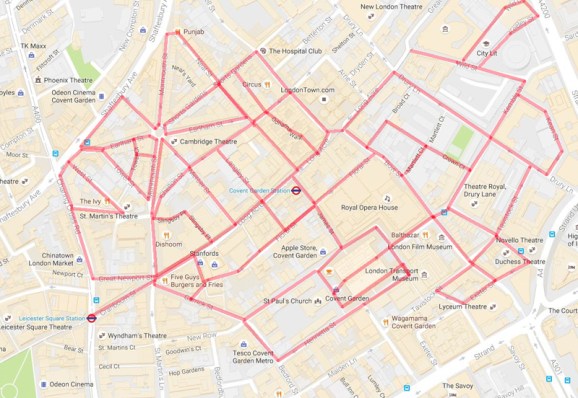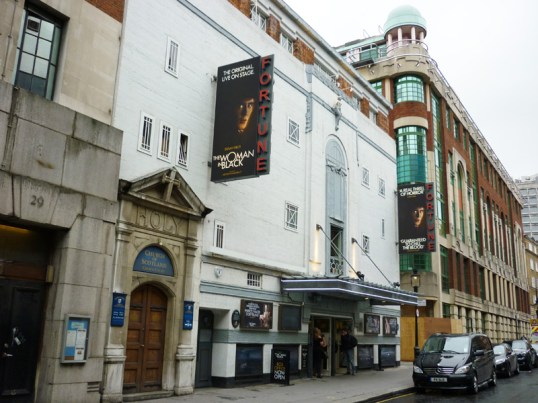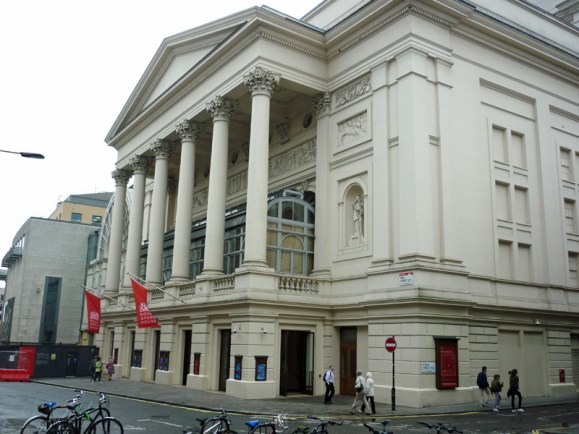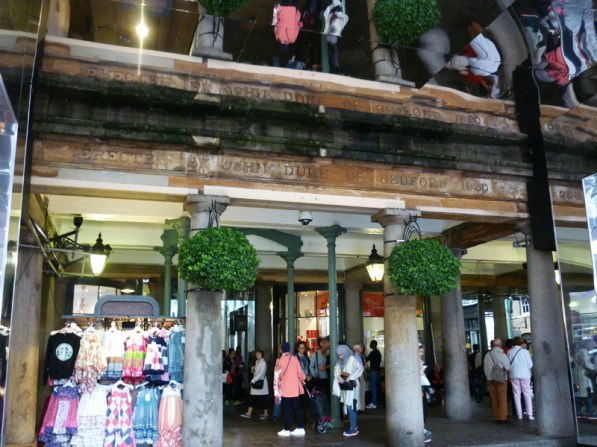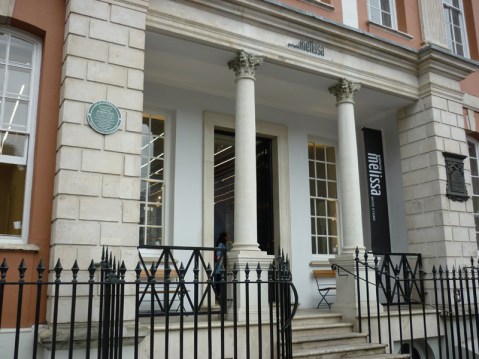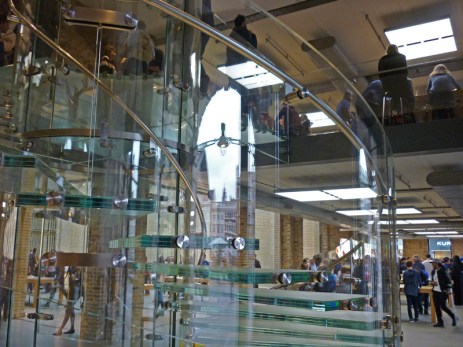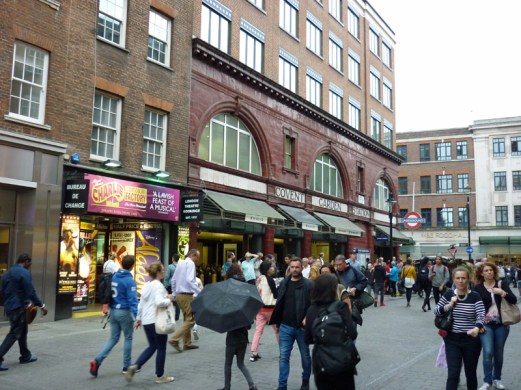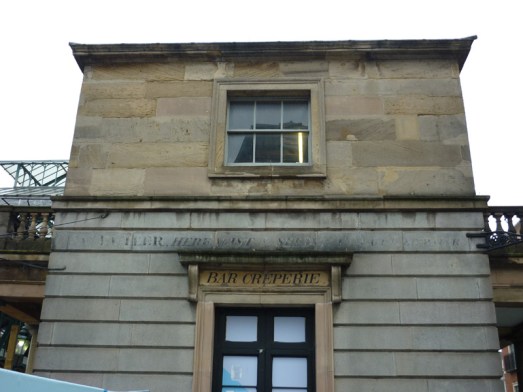Second part of today’s walk is itself split into two. First off we continue west from Liverpool Street Station and make a circuit of Finsbury Square before pausing on the eastern side of the Barbican Centre. Then it’s a return trip through the Beech Street tunnel to get to Golden Lane and its eponymous estate; after which we loop round the extensive site occupied by the Charterhouse and one of the four campuses of Queen Mary University traversing Clerkenwell Road, St John Street and Charterhouse Street to finish in Charterhouse Square.


Leaving Broadgate Circus we turn right along Eldon Street then turn back north up Finsbury Avenue which leads into Finsbury Avenue Square which contains both table tennis tables and a few pieces of public art including this piece, Rush Hour.

Exit the square from the north-east corner into Sun Street first turning left then swiftly right into Crown Place and completing a figure of eight involving those two along with Christopher Street, Earl Street and Wilson Street. Continue south on the latter past the Wilson Street Chapel which is currently besieged by both roadworks and redevelopment of the Flying Horse pub next door. The chapel was built in 1889 which (à propos of nothing) is one of the longest Roman Numeral dates to have yet occurred – MDCCCLXXXIX.

At the end of Wilson Street turn right along South Place then right again into Dominion Street facing directly towards the back entrance of City Gate House. This was constructed in the mid 1920’s to the design of Sir Giles Gilbert Scott (1880 – 1960) son of the better known and much more prolific George Gilbert Scott, creator of the Midland Hotel St Pancras (as was recorded many posts ago). Giles’ main claim to fame rests on the design of something on a much smaller scale but that’s one for our next post. City Gate House was originally built as a gentleman’s club but it’s not clear how long it lasted as such. American media giant Bloomberg acquired the building in 1991 though in 2015 they sold it on to developers (leasing it back on a temporary basis).

Turn left next along Lackington Street then north up Finsbury Pavement (part of the A501) before turning the corner into Finsbury Square. First building you come to is the Norman Foster designed no.50 which is adjacent to City Gate House and which Bloomberg expanded into in 2000. Two years later they created the Bloomberg Space on the ground floor as a showcase for newly-commissioned contemporary visual art. The exhibitions there are generally worth a visit but the current offering left me distinctly underwhelmed I’m afraid.

Continue round the square anti-clockwise passing the front of City Gate House and the drinking fountain that was erected by Tom and Walter Smith as a memorial to their mother Martha who died in 1898. Their father, another Tom, was the man who, in 1847, invented the Christmas Cracker. The business he created on the back of this, Tom Smith & Co., subsequently taken on by his three sons, operated from premises in Finsbury Square up until 1953 (when they moved to Norwich).

The north side of the square is dominated by the former Triton Court (now known as the AlphaBeta Building). Triton Court was constructed in 1920, comprising three buildings, Mercury, Jupiter and Neptune Houses, internally arranged around a full height 9 storey central atrium. It underwent a first major refurbishment in 1984 and another, costing £36m, has just been completed following the change of name. On top of the tower stands a statue of the messenger of the Gods; Hermes or Mercury depending on whether you favour the Greeks or the Romans.
After completing the circuit of Finsbury Square we head west on Chiswell Street where we pass Longbow House which now houses a branch of Currys PC World. This post-war building incorporates a relief of an archer, referencing back to the days when this area was to archery what St Andrews is to golf. That was before the advent of the musket though and the establishment of the Honourable Artillery Company whose grounds lie just to the north of here (see Day 28).

Turn south down Finsbury Street and onto Ropemaker Street then continue west past the Barbican Centre and through the Beech Street tunnel to resume the trail at the southern end of Golden Lane. Take the first left into Brackley Street and when this junctions with Viscount Street head south initially into Bridgewater Street then double back and enter the Golden Lane estate from Fann Street.
The Golden Lane Estate was built in the 1950’s in an area which, as we have seen previously, was effectively razed to the ground by the blitz. A competition for the design had been launched in 1951 and was won by Geoffrey Powell, a lecturer in architecture at Kingston School of Art. He then formed the partnership of Chamberlain, Powell & Bon with two of his fellow lecturers in order to carry out the project – the three had entered into an agreement that if any one of them won they would share the commission. The first phase was opened in 1957 and the final block completed five years later. The estate consists of a series of relatively low-level maisonette blocks and the 16-storey centrepiece, Great Arthur House, which was the first residential tower block in London over 50 metres in height. The architectural style takes definite inspiration from the work of Le Corbusier but is softened by the use of primary colours on the facades.
At the time of construction the estate was regarded enthusiastically as a template for integrated social housing and it has indubitably stood test of time better than most of its contemporaries. Unsurprisingly, given the location, slightly over half of the 559 flats have been sold on leasehold since the Thatcher government’s introduction of the right to buy scheme. The attractiveness of taking advantage of such opportunity is enhanced by a level of on-site facilities replicated in scant few other London council estates – including a leisure centre with tennis courts and an indoor pool. Since 1997 the estate buildings have been Grade II listed.
So we exit the estate back out onto Golden Lane itself and continue north before turning west onto Baltic Street East and completing a grid consisting of this, Honduras Street, Timber Street, Domingo Street, Crescent Row, Memel Street, Memel Court, Sycamore Street and Baltic Street West. And the only thing of note to record in this whole area is this doorway of a former school which I can find no information about.

Anyway, after all that we find ourselves out on the Goswell Road and then turning the corner into Clerkenwell Road where the mural that we saw back in Day 14 has now been replaced by a giant-sized Jessica Ennis-Hill.
Turn south all the way down St John Street to arrive opposite Smithfield Market then take a left down Charterhouse Street which soon splits in two. Take the left fork which takes us past a couple of pubs of note. First is the Smithfield Tavern which on the website which is still running advertises itself as Smithfields’ only vegetarian and vegan pub. You can see how well that worked from the picture below. Second is the Fox and Anchor which in its current four-storey art-nouveau facaded Grade II-listed incarnation has been around since the tail end of the 19th century (though there has been a pub of some kind here for several centuries).
Continuing on we arrive at Charterhouse Square. On the north side of the square sits the Charterhouse, a former Carthusian monastery which since Henry VIII’s dissolution of the monasteries in the 16th century the house has served as a private mansion, a boys’ school and an almshouse which it remains to this day. The site was originally set aside in the middle of the 14th century as a burial ground for victims of the Black Death and the monastery was established in 1371 on the unused portion of the land. In 1611, the year of his death, Thomas Sutton (1532 – 1611), businessman, civil servant and philanthropist, founded an almshouse for “80 impoverished gentlemen” and a school for 40 boys. Charterhouse School eventually outgrew its premises and moved to Godalming in Surrey in 1872 selling the site to another school, Merchant Taylor’s, which itself moved on in 1933. Today this part of the site is occupied by one of the four campuses of Queen Mary University London. The almshouse, which remains, is formally known as Sutton’s Hospital in Charterhouse and is a registered charity. For historic reasons the residents are still known as “Brothers”.


The entrance to the University campus is via Rutland Place at the north-east corner of the square. On the east side of this lies Dean Rees House, part of the University now but built in 1894 as the Headmaster’s House and still bearing the motif of the Merchant Taylor’s School.

The east side of Charterhouse Square itself is dominated by the Art Deco Florin Court built 1935-37 by Guy Morgan & Partners. When the building was refurbished in 1988 the original roof gardens were reinstated and a basement swimming pool added. Post-refurb and through the nineties it found fame in the guise of Whitehaven Mansions home to the TV version of Agatha Christie’s Poirot.

Leaving the square via Carthusian Street (named after those monks of course) we arrive on Aldersgate Street, flanking the west side of the Barbican complex, and the finish of today’s perambulations.







































